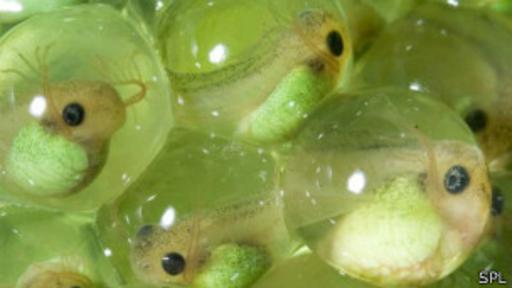Scientists discovered a frog that gives birth tadpoles directly without having laid eggs. Most amphibians reproduce by eggs, although there are some species that stop frogs.
However that of a frog tadpoles born mother is something completely new for scientific knowledge. The mysterious species in question lives in Sulawesi, an island of Indonesia.
Zoologists have followed for decades because they suspected their particular reproductive behavior.
And finally been able to testify and then describe a study published in the journal “PLoS One”.

It was Dr. Jim McGuire, of the University of California, Berkeley, USA, the first witness of this unexpected birth. In fact, until he thought he had witnessed in his hand a male frog. But he soon realized that he was holding was a pregnant female, because suddenly came out of it a handful of tadpoles.
mysterious mechanism
The nearly 6,000 species of frogs in the world use external fertilization. That is, the females lay eggs and the males fertilize them with sperm.
“But there are a lot of strange modifications of this form of standard mating,” says McGuire.
” This is one of the 10 or 12 species of frogs that have developed internal fertilization, although it is the only one who gives birth to tadpoles “qualifies.
But how do males to fertilize eggs inside the female remains a mystery, as the frogs do not have conventional sexual organs to transfer sperm.
two species found in California have developed a cola penis with that conduct that task, but it is not the case of Indonesian frog tadpoles stop.
Professor Djoko Iskandar, TECHNOLOGICAL Institute of Bandung in Indonesia and contributor McGuire, was the first scientist to spot this frog fangs in 1990 but has now been described as a distinct species. Scientists named ‘Limnonectes larvaepartus’.
The characteristic of the species belonging to the family Limnonectes are the two bumps that have in the lower jaw, which resemble two fangs and they use to fight.

“Great Discovery”
Ben Tapley, the team leader of herpetology (who studies reptiles) of the Zoological Society London, UK, said the finding “out of nowhere”, as it was not known anything like that.
“In fact, the frogs are relatively boring,” said the expert on the BBC .
“So find something totally amazing about a frog who can barely identify in a jungle is really great.”
It is believed that there are over 25 species of Limnonectes in Sulawesi , one of the four largest of the Sunda islands, Borneo and Maluku.
However, only four have been described, including occupying this article, the larvaepartus, and little is known about the biology of all of them.
“Discovering a new species is not rare, but finding a new form of reproduction yes it is,” Tapley said.
“There are more than 40 reproductive forms between the amphibians, but the frog Limnonectes larvaepartus is totally unique. “
He added that the region in which it was found has one of the highest levels of deforestation in the world.
” Such discoveries are really valuable, especially in Sulawesi, where most of the forest has disappeared, “he said.
” It’s great that we are learning about these species before it’s too late. ”
Source
No comments:
Post a Comment